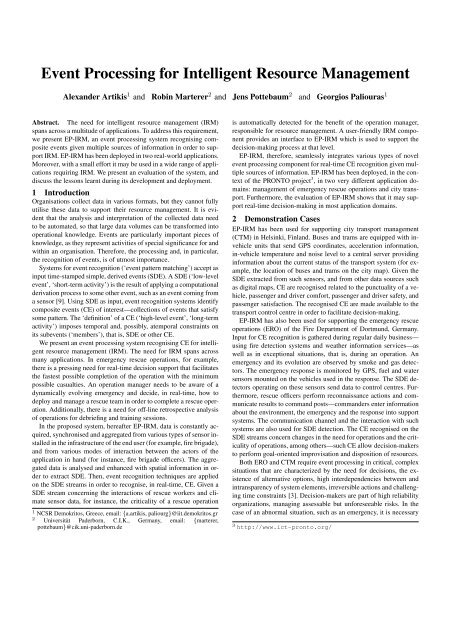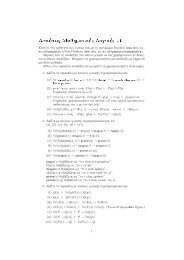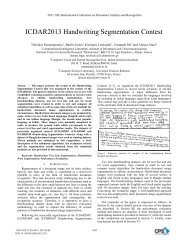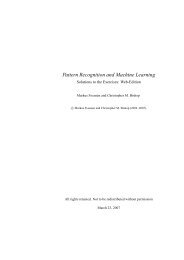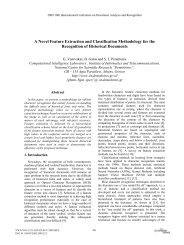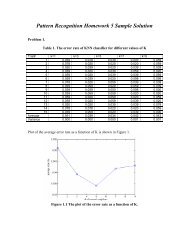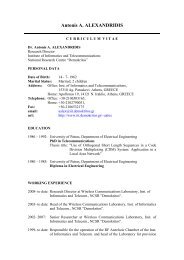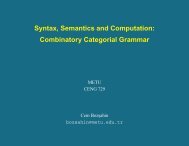European Conference on Artificial Intelligence
European Conference on Artificial Intelligence
European Conference on Artificial Intelligence
You also want an ePaper? Increase the reach of your titles
YUMPU automatically turns print PDFs into web optimized ePapers that Google loves.
Event Processing for Intelligent Resource ManagementAlexander Artikis 1 and Robin Marterer 2 and Jens Pottebaum 2 and Georgios Paliouras 1Abstract. The need for intelligent resource management (IRM)spans across a multitude of applicati<strong>on</strong>s. To address this requirement,we present EP-IRM, an event processing system recognising compositeevents given multiple sources of informati<strong>on</strong> in order to supportIRM. EP-IRM has been deployed in two real-world applicati<strong>on</strong>s.Moreover, with a small effort it may be used in a wide range of applicati<strong>on</strong>srequiring IRM. We present an evaluati<strong>on</strong> of the system, anddiscuss the less<strong>on</strong>s learnt during its development and deployment.1 Introducti<strong>on</strong>Organisati<strong>on</strong>s collect data in various formats, but they cannot fullyutilise these data to support their resource management. It is evidentthat the analysis and interpretati<strong>on</strong> of the collected data needto be automated, so that large data volumes can be transformed intooperati<strong>on</strong>al knowledge. Events are particularly important pieces ofknowledge, as they represent activities of special significance for andwithin an organisati<strong>on</strong>. Therefore, the processing and, in particular,the recogniti<strong>on</strong> of events, is of utmost importance.Systems for event recogniti<strong>on</strong> (‘event pattern matching’) accept asinput time-stamped simple, derived events (SDE). A SDE (‘low-levelevent’, ‘short-term activity’) is the result of applying a computati<strong>on</strong>alderivati<strong>on</strong> process to some other event, such as an event coming froma sensor [9]. Using SDE as input, event recogniti<strong>on</strong> systems identifycomposite events (CE) of interest—collecti<strong>on</strong>s of events that satisfysome pattern. The ‘definiti<strong>on</strong>’ of a CE (‘high-level event’, ‘l<strong>on</strong>g-termactivity’) imposes temporal and, possibly, atemporal c<strong>on</strong>straints <strong>on</strong>its subevents (‘members’), that is, SDE or other CE.We present an event processing system recognising CE for intelligentresource management (IRM). The need for IRM spans acrossmany applicati<strong>on</strong>s. In emergency rescue operati<strong>on</strong>s, for example,there is a pressing need for real-time decisi<strong>on</strong> support that facilitatesthe fastest possible completi<strong>on</strong> of the operati<strong>on</strong> with the minimumpossible casualties. An operati<strong>on</strong> manager needs to be aware of adynamically evolving emergency and decide, in real-time, how todeploy and manage a rescue team in order to complete a rescue operati<strong>on</strong>.Additi<strong>on</strong>ally, there is a need for off-line retrospective analysisof operati<strong>on</strong>s for debriefing and training sessi<strong>on</strong>s.In the proposed system, hereafter EP-IRM, data is c<strong>on</strong>stantly acquired,synchr<strong>on</strong>ised and aggregated from various types of sensor installedin the infrastructure of the end user (for example, fire brigade),and from various modes of interacti<strong>on</strong> between the actors of theapplicati<strong>on</strong> in hand (for instance, fire brigade officers). The aggregateddata is analysed and enhanced with spatial informati<strong>on</strong> in orderto extract SDE. Then, event recogniti<strong>on</strong> techniques are applied<strong>on</strong> the SDE streams in order to recognise, in real-time, CE. Given aSDE stream c<strong>on</strong>cerning the interacti<strong>on</strong>s of rescue workers and climatesensor data, for instance, the criticality of a rescue operati<strong>on</strong>1 NCSR Demokritos, Greece, email: {a.artikis, paliourg}@iit.demokritos.gr2 Universität Paderborn, C.I.K., Germany, email: {marterer,pottebaum}@cik.uni-paderborn.deis automatically detected for the benefit of the operati<strong>on</strong> manager,resp<strong>on</strong>sible for resource management. A user-friendly IRM comp<strong>on</strong>entprovides an interface to EP-IRM which is used to support thedecisi<strong>on</strong>-making process at that level.EP-IRM, therefore, seamlessly integrates various types of novelevent processing comp<strong>on</strong>ent for real-time CE recogniti<strong>on</strong> given multiplesources of informati<strong>on</strong>. EP-IRM has been deployed, in the c<strong>on</strong>textof the PRONTO project 3 , in two very different applicati<strong>on</strong> domains:management of emergency rescue operati<strong>on</strong>s and city transport.Furthermore, the evaluati<strong>on</strong> of EP-IRM shows that it may supportreal-time decisi<strong>on</strong>-making in most applicati<strong>on</strong> domains.2 Dem<strong>on</strong>strati<strong>on</strong> CasesEP-IRM has been used for supporting city transport management(CTM) in Helsinki, Finland. Buses and trams are equipped with invehicleunits that send GPS coordinates, accelerati<strong>on</strong> informati<strong>on</strong>,in-vehicle temperature and noise level to a central server providinginformati<strong>on</strong> about the current status of the transport system (for example,the locati<strong>on</strong> of buses and trams <strong>on</strong> the city map). Given theSDE extracted from such sensors, and from other data sources suchas digital maps, CE are recognised related to the punctuality of a vehicle,passenger and driver comfort, passenger and driver safety, andpassenger satisfacti<strong>on</strong>. The recognised CE are made available to thetransport c<strong>on</strong>trol centre in order to facilitate decisi<strong>on</strong>-making.EP-IRM has also been used for supporting the emergency rescueoperati<strong>on</strong>s (ERO) of the Fire Department of Dortmund, Germany.Input for CE recogniti<strong>on</strong> is gathered during regular daily business—using fire detecti<strong>on</strong> systems and weather informati<strong>on</strong> services—aswell as in excepti<strong>on</strong>al situati<strong>on</strong>s, that is, during an operati<strong>on</strong>. Anemergency and its evoluti<strong>on</strong> are observed by smoke and gas detectors.The emergency resp<strong>on</strong>se is m<strong>on</strong>itored by GPS, fuel and watersensors mounted <strong>on</strong> the vehicles used in the resp<strong>on</strong>se. The SDE detectorsoperating <strong>on</strong> these sensors send data to c<strong>on</strong>trol centres. Furthermore,rescue officers perform rec<strong>on</strong>naissance acti<strong>on</strong>s and communicateresults to command posts—commanders enter informati<strong>on</strong>about the envir<strong>on</strong>ment, the emergency and the resp<strong>on</strong>se into supportsystems. The communicati<strong>on</strong> channel and the interacti<strong>on</strong> with suchsystems are also used for SDE detecti<strong>on</strong>. The CE recognised <strong>on</strong> theSDE streams c<strong>on</strong>cern changes in the need for operati<strong>on</strong>s and the criticalityof operati<strong>on</strong>s, am<strong>on</strong>g others—such CE allow decisi<strong>on</strong>-makersto perform goal-oriented improvisati<strong>on</strong> and dispositi<strong>on</strong> of resources.Both ERO and CTM require event processing in critical, complexsituati<strong>on</strong>s that are characterized by the need for decisi<strong>on</strong>s, the existenceof alternative opti<strong>on</strong>s, high interdependencies between andintransparency of system elements, irreversible acti<strong>on</strong>s and challengingtime c<strong>on</strong>straints [3]. Decisi<strong>on</strong>-makers are part of high reliabilityorganizati<strong>on</strong>s, managing assessable but unforeseeable risks. In thecase of an abnormal situati<strong>on</strong>, such as an emergency, it is necessary3 http://www.ict-pr<strong>on</strong>to.org/
to recognise the events of interest, interpret the c<strong>on</strong>text, derive acti<strong>on</strong>alternatives and make a decisi<strong>on</strong>. Due to time c<strong>on</strong>straints, it is oftenimpossible to analyse the effects of each possible acti<strong>on</strong>. There is aneed, therefore, for CE recogniti<strong>on</strong> and decisi<strong>on</strong> support [7].IRM appSDE Detecti<strong>on</strong>subsystemSDE Detecti<strong>on</strong>comp<strong>on</strong>entMAP appFigure 1.EP-IRMApplicati<strong>on</strong> subsystemEvent BusEventVisualisati<strong>on</strong> appIntegrati<strong>on</strong> subsystemMOM comp<strong>on</strong>entCE Recogniti<strong>on</strong>subsystemCE Recogniti<strong>on</strong>comp<strong>on</strong>entStatisticsappEP-IRM architecture....ObservertoolEvent Logging and RetrievalsubsystemSemanticDataStore3 System ArchitectureEP-IRM is based up<strong>on</strong> the principles of event-driven, serviceorientedarchitectures [10]. It is divided into subsystems c<strong>on</strong>taining<strong>on</strong>e or more comp<strong>on</strong>ents—see Figure 1. Due to the modular designand loose coupling of EP-IRM, comp<strong>on</strong>ents written in variousprogramming languages can be added, replaced or removed withoutmuch effort. All subsystems are c<strong>on</strong>nected through the Message-Oriented Middleware (MOM). The MOM is based <strong>on</strong> HornetQ,which is the JBoss applicati<strong>on</strong> server implementati<strong>on</strong> of the JavaMessage Service (JMS) standard. Messages in the MOM representevents communicated between subsystems.EP-IRM includes comp<strong>on</strong>ents detecting SDE from audio, video,text, locati<strong>on</strong>, temperature, accelerati<strong>on</strong>, and vehicle engine data.Following the publish-subscribe pattern, comp<strong>on</strong>ents may act asevent producers or event c<strong>on</strong>sumers. For example, the SDE detecti<strong>on</strong>comp<strong>on</strong>ents c<strong>on</strong>sume raw events coming from sensors (microph<strong>on</strong>es,cameras, GPS, etc) in order to produce SDE. The CE recogniti<strong>on</strong>comp<strong>on</strong>ent c<strong>on</strong>sumes SDE in order to produce CE. All eventsare logged in a semantic data store which is accessible via the MOM.The applicati<strong>on</strong> subsystem includes the web applicati<strong>on</strong>s (‘apps’)directly available to the user through a web-based interface. TheStatistics app, for example, calculates and visualises event-based statisticalinformati<strong>on</strong>, such as bus/tram fuel c<strong>on</strong>sumpti<strong>on</strong> in CTM.To facilitate the communicati<strong>on</strong> between apps, an event bus is employed.Apart from web applicati<strong>on</strong>s, the applicati<strong>on</strong> subsystem isopen for integrati<strong>on</strong> with stand-al<strong>on</strong>e software tools like ‘Observer’.This tool supports post-operati<strong>on</strong> use cases such as debriefings andoperating reports. The EP-IRM applicati<strong>on</strong> subsystem and the userinterface are further discussed in Secti<strong>on</strong> 5.The system is fully functi<strong>on</strong>al and integrated into the end-users’infrastructures in Helsinki and Dortmund. The two installati<strong>on</strong>s d<strong>on</strong>ot have exactly the same modules as in CTM and ERO there aredifferent types of sensor and user interacti<strong>on</strong>. Next, we briefly presentthe CE recogniti<strong>on</strong> comp<strong>on</strong>ent. Due to space limitati<strong>on</strong>s we cannotpresent in detail the remaining EP-IRM modules.4 Composite Event Recogniti<strong>on</strong>Our comp<strong>on</strong>ent for CE recogniti<strong>on</strong> is a logic programming (Prolog)implementati<strong>on</strong> of an Event Calculus (EC) dialect. EC [8] is a logic...programming language for representing and reas<strong>on</strong>ing about eventsand their effects. The benefits of a logic programming approach toCE recogniti<strong>on</strong> are well-documented [11]: such an approach has aformal, declarative semantics, is highly expressive, has direct routesto machine learning for automatically c<strong>on</strong>structing CE definiti<strong>on</strong>s(see, for instance, [6]), and has direct routes to reas<strong>on</strong>ing under uncertaintyfor addressing the issues of noisy SDE streams and impreciseCE definiti<strong>on</strong>s (see, for example, [5]). The use of EC hasadditi<strong>on</strong>al advantages: the process of CE definiti<strong>on</strong> development isc<strong>on</strong>siderably facilitated, as EC includes built-in rules for complextemporal representati<strong>on</strong> and reas<strong>on</strong>ing, including the formalisati<strong>on</strong>of inertia. With the of EC <strong>on</strong>e may develop intuitive, succinct CEdefiniti<strong>on</strong>s, facilitating the interacti<strong>on</strong> between CE definiti<strong>on</strong> developerand domain expert, and allowing for code maintenance.4.1 Representati<strong>on</strong>For the EC dialect presented here, ‘Event Calculus for Run-Timereas<strong>on</strong>ing’ (RTEC), the time model is linear and includes integers.Where F is a fluent—a property that may have different values at differenttime-points—the term F = V denotes that fluent F has valueV . Boolean fluents are a special case in which the possible valuesare true and false. Informally, F = V holds at a particular time-pointif F = V has been initiated by an event at some earlier time-point,and not terminated by another event in the meantime (law of inertia).PredicateTable 1.Main predicates of RTEC.MeaninghappensAt(E, T ) Event E is occurring at time Tinitially(F = V ) The value of fluent F is V at time 0holdsAt(F = V, T ) The value of fluent F is V at time TholdsFor(F = V, I) I is the list of maximal intervalsfor which F = V holds c<strong>on</strong>tinuouslyinitiatedAt(F = V, T ) At time T a period of timefor which F = V is initiateduni<strong>on</strong> all(L, I ) I is the list of maximal intervalsproduced by the uni<strong>on</strong> of the listsof maximal intervals of list Lintersect all(L, I ) I is the list of maximal intervalsproduced by the intersecti<strong>on</strong> ofthe lists of maximal intervals of list LrelativeI is the list of maximal intervalscomplement all(I ′ , L, I ) produced by the relative complementof the list of maximal intervals I ′with respect toevery list of maximal intervals of list LAn event descripti<strong>on</strong> in RTEC includes axioms that define theevent occurrences (with the use of the happensAt predicates), the effectsof events (with the use of the initiatedAt predicates), and the valuesof the fluents (with the use of the initially, holdsAt and holdsForpredicates). Table 1 summarises the RTEC predicates available to theCE definiti<strong>on</strong> developer. Variables, starting with an upper-case letter,are assumed to be universally quantified unless otherwise indicated.Predicates and c<strong>on</strong>stants start with a lower-case letter.The city transport officials are interested in computing, for example,the intervals during which a vehicle is (n<strong>on</strong>-)punctual. This maybe achieved in RTEC as follows:initially(punctuality( , ) = punctual) (1)initiatedAt(punctuality(Id, VT ) = punctual, T ) ←happensAt(enter stop(Id, VT , Stop, scheduled), ),happensAt(leave stop(Id, VT , Stop, scheduled), T )initiatedAt(punctuality(Id, VT ) = punctual, T ) ←happensAt(enter stop(Id, VT , Stop, early), ),happensAt(leave stop(Id, VT , Stop, scheduled), T )(2)(3)
Time (ms)at Q i, the effects of SDE that took place in (Q i−WM, Q i−1], butarrived at RTEC after Q i−1. Moreover, it will be possible to compute,at Q i, the effects of the revisi<strong>on</strong> of SDE that took place in(Q i−WM, Q i−1] and were revised after Q i−1.Even when WM>Q i−Q i−1 informati<strong>on</strong> may be lost. The effects ofSDE that took place before or <strong>on</strong> Q i−WM and arrived after Q i−1are lost. Similarly, the effects of the revisi<strong>on</strong> of SDE that took placebefore or <strong>on</strong> Q i−WM and were revised after Q i−1 are lost. To reducethe possibility of losing informati<strong>on</strong>, <strong>on</strong>e may increase the size ofWM; in this case, however, recogniti<strong>on</strong> efficiency will decrease.RTEC is the most appropriate EC dialect for run-time CE recogniti<strong>on</strong>as, am<strong>on</strong>g others, it is the <strong>on</strong>ly EC dialect operating <strong>on</strong> WM ,being therefore independent of the complete SDE history. A detailedaccount of our CE recogniti<strong>on</strong> comp<strong>on</strong>ent and a comparis<strong>on</strong> withrelated (EC-based) approaches are given in [2].When SDE arrive with a variable delay, or when SDE are revisedby the SDE detecti<strong>on</strong> comp<strong>on</strong>ents, some of the CE intervals computedand stored at an earlier query time may be, partly or completely,retracted at the current or a future query time. Depending<strong>on</strong> the requirements of the applicati<strong>on</strong> under c<strong>on</strong>siderati<strong>on</strong>, RTECmay report to the user:• CE as so<strong>on</strong> as they are recognised, even though the intervals ofthese CE may be partly or completely retracted in the future.• CE whose intervals may be partly, but not completely, retracted inthe future.• CE whose intervals will not be, even partly, retracted in the future.5 Evaluati<strong>on</strong>By far the most computati<strong>on</strong>ally expensive EP-IRM comp<strong>on</strong>ent is theCE recogniti<strong>on</strong> comp<strong>on</strong>ent. Moreover, CTM proved to be more computati<strong>on</strong>allydemanding than ERO with respect to CE recogniti<strong>on</strong>.Therefore, we present experimental results c<strong>on</strong>cerning CE recogniti<strong>on</strong>for CTM. The experiments were performed <strong>on</strong> a computer withIntel i7 950@3.07GHz processors and 12GiB RAM, running UbuntuLinux 11.04 and YAP Prolog 6.2.0.Figure 2 shows the results of experiments c<strong>on</strong>cerning CE recogniti<strong>on</strong>at rush hour in Helsinki. At most 1050 vehicles, that is, 80%of the total number of available vehicles, operate at the same time inHelsinki during rush hour. Due to the unavailability of real datasetsat that scale, we simulated rush hour operati<strong>on</strong>s using syntheticdatasets. Experts estimate that no more than 350 SDE can be detectedper sec<strong>on</strong>d <strong>on</strong> the 1050 operating vehicles. We were thus ableto test RTEC under the maximum expected frequency of SDE.Figure 2 presents the recogniti<strong>on</strong> times of RTEC in CPU millisec<strong>on</strong>ds(ms) c<strong>on</strong>cerning three sets of experiments. First, we used a singleprocessor to perform CE recogniti<strong>on</strong> for all 1050 vehicles. In thiscase, the intervals of 21000 CE (1050 vehicles × 20 CE per vehicle)are computed and stored. Sec<strong>on</strong>d, we used four processors inparallel. Each instance of RTEC running <strong>on</strong> a processor performedCE recogniti<strong>on</strong> for <strong>on</strong>e quarter of all operating vehicles, that is, 263vehicles, computing and storing the intervals of 5260 CE. Third, weused all eight processors of the computer in parallel. Each instanceof RTEC running <strong>on</strong> a processor performed CE recogniti<strong>on</strong> for <strong>on</strong>eeighth of all operating vehicles, that is, 132 vehicles, and computedand stored the intervals of 2640 CE.In all sets of experiments the input was the same: SDE comingfrom all 1050 vehicles. In other words, there was no filtering of SDEin these experiments to restrict the input relevant for each processor.The datasets used for evaluati<strong>on</strong> include SDE that are not chr<strong>on</strong>ologicallyordered. The step is set to 1 sec (350 SDE), while WM450400350300250200150100500Figure 2.1 processor 4 processors 8 processorsWorking MemoryTotal RTEC time: CE recogniti<strong>on</strong> during rush hour in Helsinki,step set to 1 sec = 350 SDE.ranges from 4 sec (1400 SDE) to 25 sec (8750 SDE). We found (inexperiments not presented here due to lack of space) that reducingthe step size reduces recogniti<strong>on</strong> times very slightly. Given the currentinfrastructure in Helsinki, a 10 sec WM is sufficient, that is, adelay in the arrival of a SDE is expected to be less than 10 sec. OtherCTM infrastructures may require different WM sizes.Figure 2 shows that we can achieve a significant performance gainby running RTEC in parallel <strong>on</strong> different processors. Such a gain isachieved without requiring SDE filtering.Apart from quantitative evaluati<strong>on</strong>, we performed qualitative,user-oriented evaluati<strong>on</strong>—we estimated the impact of EP-IRM <strong>on</strong>the end user organisati<strong>on</strong>s by means of interviews. Qualitative evaluati<strong>on</strong>is related to questi<strong>on</strong>s of effectiveness (does EP-IRM fit toits intended purpose?), efficiency (does EP-IRM facilitate quick taskc<strong>on</strong>ducti<strong>on</strong>?) and user satisfacti<strong>on</strong> (do users feel comfortable usingEP-IRM?). In what follows, we briefly discuss the qualitative evaluati<strong>on</strong>of EP-IRM <strong>on</strong> ERO. This type of evaluati<strong>on</strong> was c<strong>on</strong>siderablyaided by the visualisati<strong>on</strong> capabilities of EP-IRM—see Figure 3. Usecases are implemented by several apps which build the integrateduser interface. Each of the apps is represented by a window. Realtimeinformati<strong>on</strong>, including the CE and SDE recognised at each time,is c<strong>on</strong>tinuously updated without user interacti<strong>on</strong> (push paradigm). Auser bar allows the c<strong>on</strong>figurati<strong>on</strong> of apps and views. On the left handside, each app can be switched <strong>on</strong> or off by a butt<strong>on</strong>. On the righthand side, different views for different user roles and operati<strong>on</strong> c<strong>on</strong>textcan be selected.The IRM app, for example, shows a logical view of the system’sstatus. For example, in ERO the IRM app displays a tree view of therescue operati<strong>on</strong> command structure current at each time. Moreover,it shows the list of dangers of an operati<strong>on</strong>, highlighting new <strong>on</strong>es inorder to enable a commander to react to them. The MAP app presentsa geo-based view of the system’s status. For example, it displays positi<strong>on</strong>sof vehicles (fire brigade vehicles in ERO and buses and tramsin CTM) and additi<strong>on</strong>al vehicle informati<strong>on</strong> or marked z<strong>on</strong>es. Interacti<strong>on</strong>sbetween vehicles and spatial entities (such as an emergencyarea in ERO or a a dangerous intersecti<strong>on</strong> in CTM) are prominentlyhighlighted. All apps are c<strong>on</strong>nected to each other (via an event bus).For instance, when a new danger occurs and is shown in the IRMapp, the user can click <strong>on</strong> it and its positi<strong>on</strong> as well as related informati<strong>on</strong>(such as a photo of the danger locati<strong>on</strong>) will be presented <strong>on</strong>the MAP app. Apps act as event c<strong>on</strong>sumers—for instance, the EventVisualisati<strong>on</strong> app c<strong>on</strong>sumes SDE and CE in order to display them in
ti<strong>on</strong>s to members of the end user organisati<strong>on</strong>s <strong>on</strong> how to improvedata collecti<strong>on</strong> and annotati<strong>on</strong>. To allow for testing EP-IRM at theearly stages of the project where sufficient data were unavailable, wedeveloped data generators simulating CTM and ERO operati<strong>on</strong>s.End users are not always able to quantitatively estimate eventrecogniti<strong>on</strong>. Therefore we had to extend the validati<strong>on</strong> approach of[12] by allowing for qualitative evaluati<strong>on</strong>. Users do not always thinkof millisec<strong>on</strong>ds—they sometimes think about the processes beforewhich a CE should be recognised. For example, the ‘demand for additi<strong>on</strong>alresources’ ERO CE should be recognised anytime before thefollowing rec<strong>on</strong>naissance. One aspect that we did not anticipate c<strong>on</strong>cernsthe fact that end users do not always have high performancerequirements. For example, some rescue officers accepted delays upto <strong>on</strong>e minute c<strong>on</strong>cerning the recogniti<strong>on</strong> of some CE because theywould not be able to use this informati<strong>on</strong> (recognised CE) earlier.This is supported by the fact that briefings, debriefings and operatingreports are highlighted as major use cases for EP-IRM in additi<strong>on</strong> toreal-time event recogniti<strong>on</strong> and visualisati<strong>on</strong>.C<strong>on</strong>cerning recogniti<strong>on</strong> accuracy, the assumpti<strong>on</strong> of perfect precisi<strong>on</strong>and recall was challenged by end users. A 95% accuracy isacceptable by most users. The accuracy of EP-IRM, therefore, wasfound acceptable. The interviews showed that the impact of falsenegatives is diverse. In some cases, such as when a ‘resource departed’in order to participate in an emergency operati<strong>on</strong>, but this CEwas not recognised, false negatives lead to an overestimati<strong>on</strong> of thenecessary resources, but have no negative influence <strong>on</strong> an emergency.The impact of false positives is much more critical up to ‘not acceptable’.Only a few officers deviate from this judgement who woulddouble-check informati<strong>on</strong> provided by an event processing system.End users benefit from, and often demand, explanati<strong>on</strong> facilitiesfrom the event processing system. When various recognised CE werepresented to the users, an explanati<strong>on</strong> c<strong>on</strong>cerning CE recogniti<strong>on</strong> wasrequired (‘drill down’)—what are the occurrences of the subevents ofthe CE that lead to the CE recogniti<strong>on</strong>? Such a feature is deemed necessaryboth for run-time and off-line use of the system. Building up<strong>on</strong>Prolog’s tracing facility, we can already offer a form of explanati<strong>on</strong>facility.7 Summary & TransferabilityWe presented EP-IRM, an event processing system supporting intelligentresource management. EP-IRM seamlessly integrates varioustypes of novel event processing comp<strong>on</strong>ent for CE recogniti<strong>on</strong> givenmultiple sources of informati<strong>on</strong>, including various types of sensorand modes of actor interacti<strong>on</strong>. The complex CTM and ERO CE definiti<strong>on</strong>senabled us to perform a realistic evaluati<strong>on</strong> of the performanceof EP-IRM. According to the results of the use case surveyof the Event Processing Technical Society [4], in most applicati<strong>on</strong>domains there are at most 1000 SDE per sec<strong>on</strong>d. Our experimentalevaluati<strong>on</strong> showed that EP-IRM supports real-time decisi<strong>on</strong>-makingin such domains.EP-IRM has been deployed in the two very different applicati<strong>on</strong>domains of ERO and CTM. Below we discuss what needs to be d<strong>on</strong>ein order to use EP-IRM in other domains.If necessary, the MOM may be replaced by any JMS implementati<strong>on</strong>.Many apps are generic and may be used in several applicati<strong>on</strong>domains (for example, the same MAP and Event Visualisati<strong>on</strong> appsare used both in CTM and ERO), while some are domain-specific.The apps are independent and may be replaced, and new <strong>on</strong>es added,seamlessly. Most SDE detecti<strong>on</strong> comp<strong>on</strong>ents may be easily reusedin any applicati<strong>on</strong> domain. The audio SDE detecti<strong>on</strong> comp<strong>on</strong>ent, forexample, c<strong>on</strong>sists of a model-free approach that may work in manyfields without much adaptati<strong>on</strong>. The video comp<strong>on</strong>ent for unusualSDE detecti<strong>on</strong> may be employed in any domain in which there isa need for m<strong>on</strong>itoring (large) human crowds. Its sensitivity may beadapted by adjusting <strong>on</strong>ly a small number of parameters. Moreover,it is nearly independent from the camera viewpoint.On the c<strong>on</strong>trary, the speech detecti<strong>on</strong> comp<strong>on</strong>ent used in ERO hasto be adapted heavily for each new applicati<strong>on</strong> domain. Currently itis optimised for TETRA radio messages in German in the setting offire fighter operati<strong>on</strong>s. Changing these c<strong>on</strong>diti<strong>on</strong>s needs major effort.In some applicati<strong>on</strong> domains it may be required to use a subsetof the EP-IRM modules—for example, there is no need for speechdetecti<strong>on</strong> in CTM. The modular design and loose coupling of EP-IRM facilitates the process of removing/adding modules.The reas<strong>on</strong>ing algorithms of the CE recogniti<strong>on</strong> comp<strong>on</strong>ent aregeneric and may de directly used in any applicati<strong>on</strong> domain. If EP-IRM is used for CTM or ERO using another transport or fire brigadeinfrastructure, for example CTM in L<strong>on</strong>d<strong>on</strong>, then the CE definiti<strong>on</strong>library may need to be updated in order to meet the requirements ofthe new infrastructure—c<strong>on</strong>sider, for instance, the use of differentSDE. In this case, transfer learning techniques may be used to portthe existing CE definiti<strong>on</strong> library to the new domain. In any case,the techniques for incremental, supervised machine learning developedin the c<strong>on</strong>text of the project [6] may be used for the automaticc<strong>on</strong>structi<strong>on</strong>/refinement of CE definiti<strong>on</strong>s. These techniques use SDEstreams annotated with CE to c<strong>on</strong>tinuously update the structure ofexisting CE definiti<strong>on</strong>s or c<strong>on</strong>struct definiti<strong>on</strong>s of new CE. Apartfrom members of the end user organisati<strong>on</strong>s, the annotati<strong>on</strong> of SDEstreams with CE may be performed by the users of the applicati<strong>on</strong>under c<strong>on</strong>siderati<strong>on</strong>—for instance, people using public transportati<strong>on</strong>communicating when a particular vehicle is driven in an unsafemanner, when passenger satisfacti<strong>on</strong> is reducing, and so <strong>on</strong>.ACKNOWLEDGEMENTSThis work has been funded by the EU PRONTO project (FP7-ICT231738).REFERENCES[1] D. Anicic, S. Rudolph, P. Fodor, and N. Stojanovic, ‘Retractable complexevent processing and stream reas<strong>on</strong>ing’, in RuleML Europe, pp.122–137, (2011).[2] A. Artikis, M. Sergot, and G. Paliouras, ‘Run-time composite eventrecogniti<strong>on</strong>’, in Proceedings of DEBS. ACM, (2012).[3] A. Bennet and D. Bennet, Handbook <strong>on</strong> Decisi<strong>on</strong> Support Systems,chapter The Decisi<strong>on</strong>-Making Process for Complex Situati<strong>on</strong>s in aComplex Envir<strong>on</strong>ment, 3–20, Springer, 2008.[4] P. Bizzaro. Results of the survey <strong>on</strong> event processing use cases. EventProcessing Technical Society, 2011.[5] J. Filippou, A. Artikis, A. Skarlatidis, and G. Paliouras, ‘A probabilisticlogic programming event calculus’, Technical report, Cornell UniversityLibrary, (2012). http://arxiv.org/abs/1204.1851v1.[6] N. Katzouris, J. Filippou, A. Skarlatidis, A. Artikis, and G. Paliouras.Final versi<strong>on</strong> of algorithms for learning event definiti<strong>on</strong>s. Deliverable4.3.2 of PRONTO, 2012. Available from the authors.[7] Gary A. Klein, ‘A recogniti<strong>on</strong>-primed decisi<strong>on</strong> (RPD) model of rapiddecisi<strong>on</strong> making’, in Decisi<strong>on</strong> Making in Acti<strong>on</strong>: Models and Methods,138–147, Norwood: Ablex Publishing Corporati<strong>on</strong>, (1993).[8] R. Kowalski and M. Sergot, ‘A logic-based calculus of events’, NewGenerati<strong>on</strong> Computing, 4(1), 67–96, (1986).[9] D. Luckham and R. Schulte. Event processing glossary. Event ProcessingTechnical Society, 2008.[10] G. Mühl, L. Fiege, and P. R. Pietzuch, Distributed event-based systems,Springer, 2006.[11] A. Paschke and M. Bichler, ‘Knowledge representati<strong>on</strong> c<strong>on</strong>cepts forautomated SLA management’, Decisi<strong>on</strong> Support Systems, 46(1), 187–205, (2008).[12] E. Rabinovich, O. Etzi<strong>on</strong>, S. Archushin, and S. Ruah, ‘Analyzing thebehavior of event processing applicati<strong>on</strong>s’, in DEBS, ACM, (2010).


